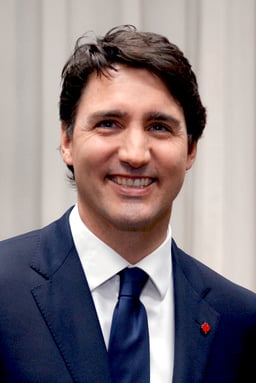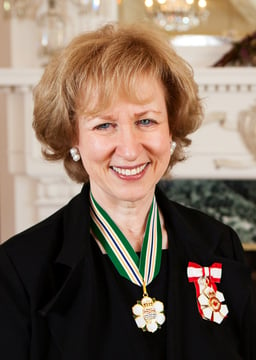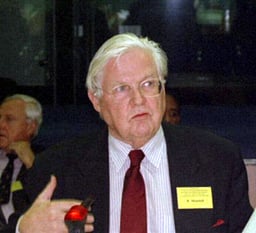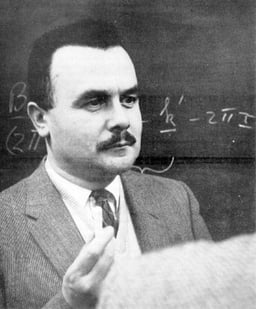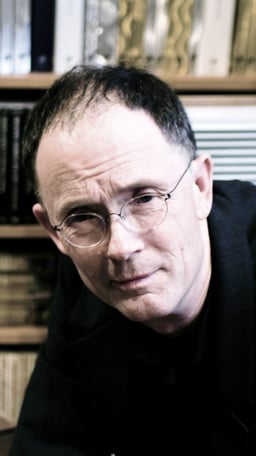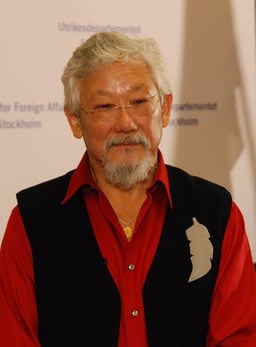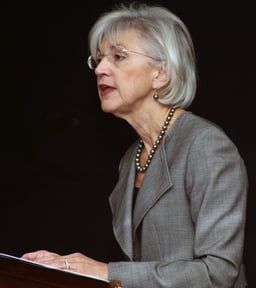University of British Columbia
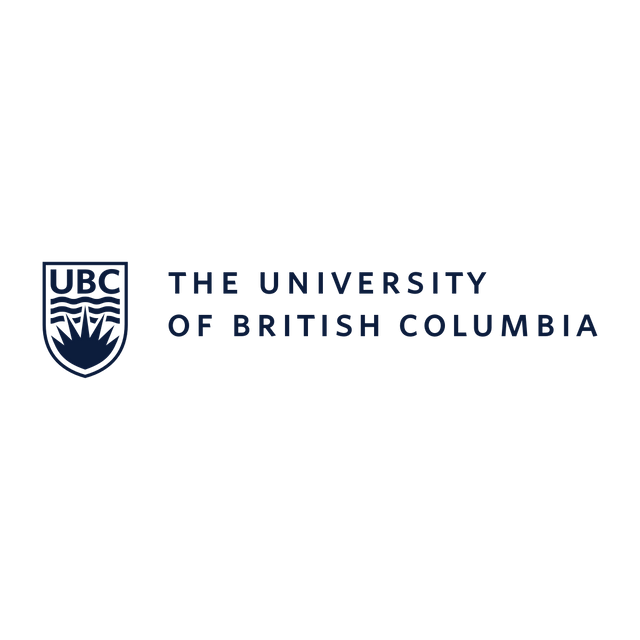
University of British Columbia

 University of British Columbia coat of arms | |
| Motto | Latin: Tuum Est[1] |
|---|---|
Motto in English | It is up to you It is yours |
| Established | 1908 |
| Endowment | CAD$2.182billion (2019)[2] |
| Budget | CAD$2.6billion (2018)[3] |
| Chancellor | Lindsay Gordon |
| President | Santa J. Ono |
| Provost | Andrew Szeri (Vancouver) and Cynthia Mathieson (Okanagan) |
Academic staff | 5,003 (Vancouver) 471 (Okanagan)[4] |
Administrative staff | 9,550 (Vancouver) 636 (Okanagan)[4] |
| Students | 64,900[5] |
| Undergraduates | 44,378 (Vancouver) 8,264 (Okanagan)[5] |
| Postgraduates | 9,941 (Vancouver) 856 (Okanagan)[5] |
| Location | Vancouver, British Columbia, Canada
|
| Campus | Vancouver: 4.02 km2(993 acres) Okanagan: 2.086 km2(515 acres) |
| Language | English |
| Newspaper | The Ubyssey |
| Colours | Blue and Gold[6] |
| Athletics | U Sports CWUAA NWAIA |
| Nickname | Thunderbird (Vancouver) Heat (Okanagan) |
| Affiliations | APLU, APRU, ASAIHL, AUCC, U15, Universitas 21. |
| Website | ubc.ca [165] |
| University rankings | |
| Global rankings | |
| ARWU World[7] | 35 |
| QS World[8] | 51 |
| Times World[9] | 34 |
| Times Reputation[50] | 40 |
| Times Employability[51] | 56 |
| U.S News & World Report Global[10] | 29 |
| Canadian rankings | |
| ARWU National[7] | 2 |
| QS National[8] | 3 |
| Times National[9] | 2 |
| U.S News & World Report National[10] | 2 |
| Maclean's Medical/Doctoral[52] | 3 |
| Maclean's Reputation[53] | 3 |
The University of British Columbia (UBC) is a public research university with campuses in Vancouver and Kelowna, British Columbia. Established in 1908, UBC is British Columbia's oldest university. The university has ranked among the top three universities in Canada.[7][8][9][10] With an annual research budget of $600 million, UBC funds over 8,000 projects a year.[4]
The Vancouver campus is situated about 10 km (6 mi) west of Downtown Vancouver.[11] UBC is home to TRIUMF, Canada's national laboratory for particle and nuclear physics, which houses the world's largest cyclotron. In addition to the Peter Wall Institute for Advanced Studies and Stuart Blusson Quantum Matter Institute, UBC and the Max Planck Society collectively established the first Max Planck Institute in North America, specializing in quantum materials.[12] One of the largest research libraries in Canada, the UBC Library system has over 9.9 million volumes among its 21 branches.[13][14] The Okanagan campus, acquired in 2005, is located in Kelowna, British Columbia.
As of 2017, eight Nobel laureates, 71 Rhodes scholars, 65 Olympians, ten fellows in both American Academy of Arts & Sciences and the Royal Society, and 208 fellows to the Royal Society of Canada have been affiliated with UBC.[4] Three Canadian prime ministers, including Canada's first female prime minister Kim Campbell and current prime minister Justin Trudeau have been educated at UBC.[15]
 University of British Columbia coat of arms | |
| Motto | Latin: Tuum Est[1] |
|---|---|
Motto in English | It is up to you It is yours |
| Established | 1908 |
| Endowment | CAD$2.182billion (2019)[2] |
| Budget | CAD$2.6billion (2018)[3] |
| Chancellor | Lindsay Gordon |
| President | Santa J. Ono |
| Provost | Andrew Szeri (Vancouver) and Cynthia Mathieson (Okanagan) |
Academic staff | 5,003 (Vancouver) 471 (Okanagan)[4] |
Administrative staff | 9,550 (Vancouver) 636 (Okanagan)[4] |
| Students | 64,900[5] |
| Undergraduates | 44,378 (Vancouver) 8,264 (Okanagan)[5] |
| Postgraduates | 9,941 (Vancouver) 856 (Okanagan)[5] |
| Location | Vancouver, British Columbia, Canada
|
| Campus | Vancouver: 4.02 km2(993 acres) Okanagan: 2.086 km2(515 acres) |
| Language | English |
| Newspaper | The Ubyssey |
| Colours | Blue and Gold[6] |
| Athletics | U Sports CWUAA NWAIA |
| Nickname | Thunderbird (Vancouver) Heat (Okanagan) |
| Affiliations | APLU, APRU, ASAIHL, AUCC, U15, Universitas 21. |
| Website | ubc.ca [165] |
| University rankings | |
| Global rankings | |
| ARWU World[7] | 35 |
| QS World[8] | 51 |
| Times World[9] | 34 |
| Times Reputation[50] | 40 |
| Times Employability[51] | 56 |
| U.S News & World Report Global[10] | 29 |
| Canadian rankings | |
| ARWU National[7] | 2 |
| QS National[8] | 3 |
| Times National[9] | 2 |
| U.S News & World Report National[10] | 2 |
| Maclean's Medical/Doctoral[52] | 3 |
| Maclean's Reputation[53] | 3 |
History
Foundation and early years
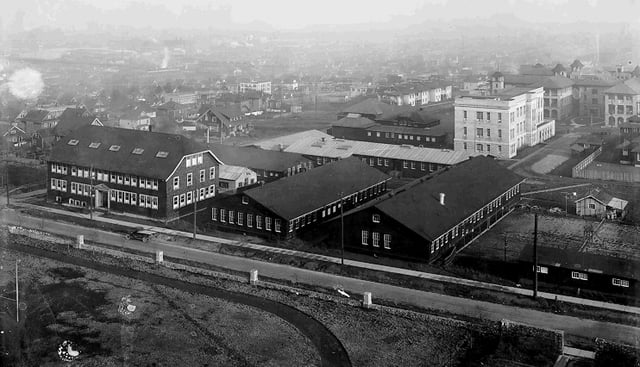
View of the UBC Fairview campus from the roof of King Edward High School (c. 1917) (Vancouver, British Columbia) (photo by Canadian Photo Co.)
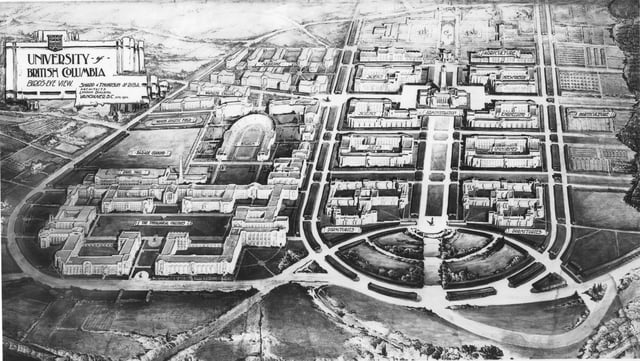
Original 1914 plan of the UBC campus, by architects Sharp and Thompson
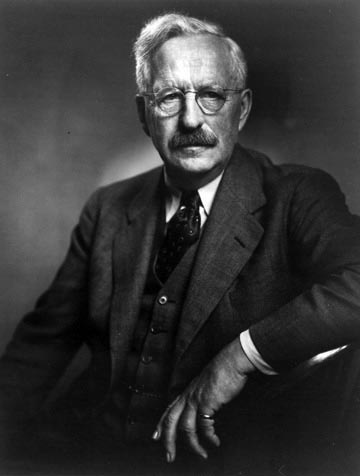
Henry Marshall Tory
In 1877, six years after British Columbia joined Canada, the Superintendent of Education, John Jessop, submitted a proposal for the formation of a provincial University. The provincial legislature passed An Act Respecting the University of British Columbia in 1890, but disagreements arose over whether to build the University on Vancouver Island or the mainland.
The British Columbia University Act of 1908 formally called a provincial University into being, although its location was not specified.[17] The governance was modelled on the provincial University of Toronto Act of 1906 which created a bicameral system of university government consisting of a senate (faculty), responsible for academic policy, and a board of governors (citizens) exercising exclusive control over financial policy and having formal authority in all other matters. The president, appointed by the board, was to provide a link between the two bodies and to perform institutional leadership.[17] The Act constituted a twenty-one member senate with Francis Carter-Cotton of Vancouver as chancellor.[18]
Before the University Act, there had been several attempts at creating a degree-granting University with help from the Universities of Toronto and McGill. Columbian College in New Westminster, through its affiliation with Victoria College of the University of Toronto, began to offer university-level credit at the turn-of-the-century, but McGill came to dominate higher education in the early 1900s.
Building on a successful affiliation between Vancouver and Victoria high schools with McGill University, Henry Marshall Tory[19] helped establish the McGill University College of British Columbia. From 1906 to 1915, McGill BC (as it was called) operated as a private institution providing the first few years toward a degree at McGill University or elsewhere. The Henry Marshall Tory Medal was established in 1941 by Tory, founding president of the University of Alberta and of the National Research Council of Canada, and a co-founder of Carleton University.
In the meantime, appeals were made to the government to revive the earlier legislation for a provincial institution, leading to the University Endowment Act in 1907, and the University Act in 1908. In 1910 the Point Grey site was chosen, and the government appointed Dr. Frank Fairchild Wesbrook as president in 1913, and Leonard Klinck as dean of Agriculture in 1914. A declining economy and the outbreak of war in August 1914 compelled the University to postpone plans for building at Point Grey, and instead the former McGill University College site at Fairview became home to the University until 1925. On the first day of lectures was September 30, 1915, the new independent university absorbed McGill University College. The University of British Columbia awarded its first degrees in 1916,[17] and Klinck became the second president in 1919, serving until 1940.
Move to Point Grey
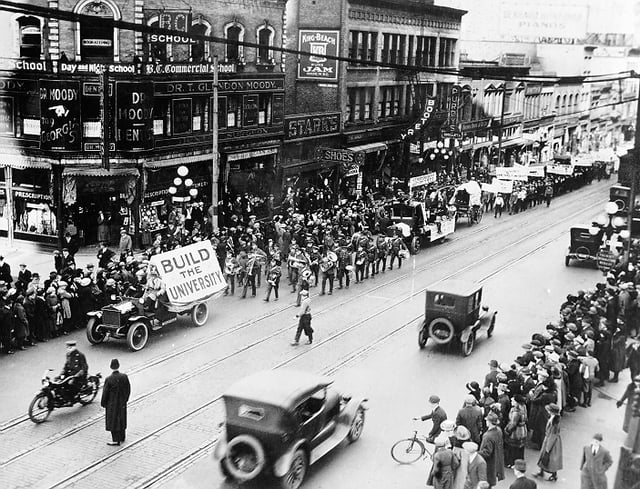
Students march down Granville Street during the Great Trek.
World War I dominated campus life and the student body was "decimated" by enlistments for active service, with three hundred UBC students in Company "D" alone. By the war's end 697 members of the University had enlisted. 109 students graduated in the three war-time congregations, all but one in the Faculty of Arts and Science.
By 1920, the University had only three faculties: Arts, Applied Science, and Agriculture (with Departments of Agronomy, Animal Husbandry, Dairying, Horticulture and Poultry). It only awarded the degrees of Bachelor of Arts (BA), Bachelor of Applied Science (BASc), and Bachelor of Science in Agriculture (BSA).[20] There were 576 male students and 386 female students in the 1920–21 winter session, but only 64 academic staff, including 6 women.[21]
In the early part of the 20th century, professional education expanded beyond the traditional fields of theology, law and medicine. Although UBC did not offer degrees in these fields, it began to offer degrees in new professional areas such as engineering, agriculture, nursing and school teaching. It also introduced graduate training based on the German-inspired American model of specialized course work and the completion of a research thesis, with students completing M.A. degrees in natural sciences, social sciences and humanities.[17]
In 1922, the twelve-hundred-strong student body embarked on a "Build the University" campaign. Students marched through the streets of Vancouver to draw attention to their plight, enlist popular support, and embarrass the government. Fifty-six thousand signatures were presented at legislature in support of the campaign, which was ultimately successful. On September 22, 1925, lectures began at the new Point Grey campus. Except for the Library, Science and Power House buildings, all the campus buildings were temporary constructions. Students built two playing fields, but the University had no dormitories and no social centre. Still, the University continued to grow steadily.
Soon, however, the effects of the depression began to be felt. The provincial government, upon which the University depended heavily, cut the annual grant severely. In 1932–33, salaries were cut by up to 23%. Posts remained vacant, and a few faculty lost their jobs. Most graduate courses were dropped. In 1935, the University established the Department of Extension. Just as things began to improve, World War II began and Canada declared war on September 10, 1939. Soon afterwards, University President Klinck wrote:
From the day of the declaration of war, the University has been prepared to put at the disposal of the Government all possible assistance by way of laboratories, equipment and trained personnel, insofar as such action is consistent with the maintenance of reasonably efficient instructional standards. To do less would be unthinkable.
Heavy rains and melting snowfall eroded a deep ravine across the north end of the campus, in the Grand Campus Washout of 1935. The campus did not have storm drains, and surface runoff went down a ravine to the beach. When the University carved a ditch to drain flooding on University Avenue, the rush of water steepened the ravine and eroded it back as fast as 10 feet (3.0 m) per hour. The resulting gully eventually consumed 100,000 cubic yards (76,455 m3), two bridges, and buildings near Graham House. The University was closed for 4 and a half days. Afterwards, the gully was filled with debris from a nearby landslide, and only traces are visible today.[22]
Military training on the campus became popular, then mandatory. WWII marked the first provision of money from the federal government to the University for research purposes. This laid a foundation for future research grants from the federal government of Canada.
Postwar years
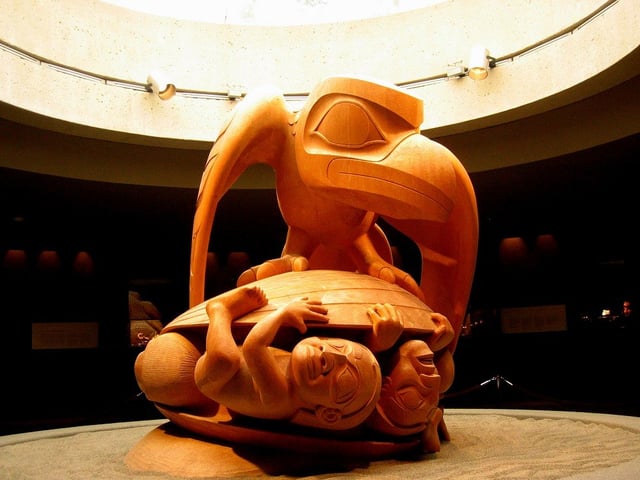
Bill Reid's Raven and The First Men at the UBC Museum of Anthropology
By the end of World War II, Point Grey's facilities could not meet the influx of veterans returning to their studies. The University needed new staff, courses, faculties, and buildings for teaching and accommodation. The student population rose from 2,974 in 1944–45 to 9,374 in 1947–48. Surplus Army and Air Force camps were used for both classrooms and accommodation. The University took over fifteen complete camps during the 1945–46 session, with a sixteenth camp on Little Mountain, in Vancouver, converted into suites for married students. Most of the camps were dismantled and carried by barge or truck to the University where the huts were scattered across the campus.
Student numbers hit 9,374 in 1948; more than 53% of the students were war veterans in 1947–67. Between 1947 and 1951, the University built twenty new permanent buildings, including the War Memorial Gym, built with money raised primarily by the students, was dedicated on October 26, 1951.[23]
The single-University policy in the West was changed as existing colleges of the provincial Universities gained autonomy as Universities – the University of Victoria was established in 1963.[17]
On February 10, 1964 Harvey Reginald MacMillan donated $8.2 million for postgraduate education to the University.[24]
Recent history
Prime Minister Pierre Trudeau announced the creation of the Museum of Anthropology at UBC on 1 July 1971. At a construction cost of $2.5 million the museum building, designed by Arthur Erickson, opened in 1976.[24] That same year, the University launched a normal school program under the direction of Sally Rogow to train educators methods to teach students with multiple disabilities or were visually impaired.[25]
UBC's 15th president is Professor Santa J. Ono. He assumed the presidency on August 15, 2016. He served previously as the 28th president of the University of Cincinnati. Dr. Martha Piper – who served as the 11th president of the University – served as interim president from September 1, 2015, to June 30, 2016, following the resignation of Dr. Arvind Gupta.
Campuses
Vancouver
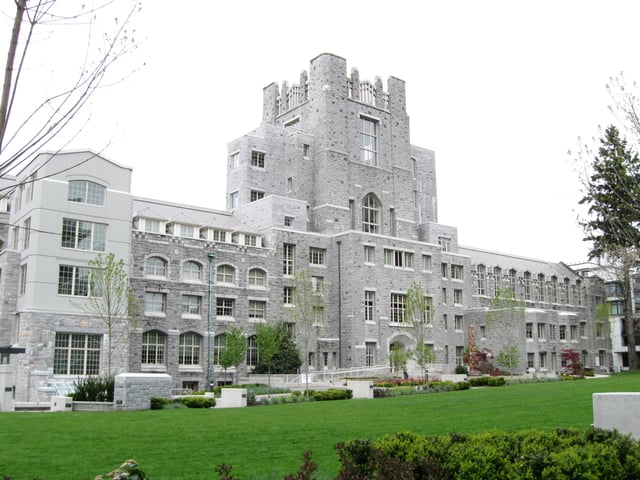
The UBC Vancouver School of Economics building, built in 1927
The main campus is at Point Grey, approximately 10 kilometres (6.2 mi) from downtown Vancouver. It is near several beaches and has views of the North Shore mountains. The 7.63-square-kilometre (1,890-acre) Pacific Spirit Regional Park serves as a green-belt between the campus and the city. Buildings on the Vancouver campus occupy 1.09 million m2 (11.7 million sq ft) gross on 1.7 square kilometres (420 acres) of maintained land. The campus street plan is mostly in a grid of malls (some of which are pedestrian-only). Lower Mall and West Mall are in the southwestern part of the peninsula, with Main, East, and Wesbrook Malls northeast of them.
The campus is not within Vancouver's city limits, and therefore UBC is policed by the RCMP rather than the Vancouver Police Department. However, the Vancouver Fire Department provides service to UBC under a contract. In addition to UBC RCMP, there is also the UBC Campus Security that patrols the campus. Postage sent to any building on campus includes Vancouver in the address.
UBC Vancouver also has two satellite campuses within the City of Vancouver: at Vancouver General Hospital, for the medical sciences, and at Robson Square in downtown Vancouver, for part-time credit and non-credit programmes. UBC is also a partner in the consortium backing Great Northern Way Campus Ltd, and is affiliated with a group of adjacent theological colleges, which include the Vancouver School of Theology, Regent College, Carey Theological College and Corpus Christi College.
The campus is home to numerous gardens. The UBC Botanical Garden and Centre for Plant Research, the first UBC department, holds a collection of over 8000 different kinds of plants used for research, conservation and education. The UBC botanical garden's original site was at the "Old Arboretum". All that remains of it today are trees planted in 1916 by John Davidson. The old arboretum is now home to many buildings including the First Nations House of Learning. The Nitobe Memorial Garden, built to honour Japanese scholar Inazo Nitobe, the garden has been the subject of more than fifteen years' study by a UBC professor, who believes its construction hides a number of impressive features, including references to Japanese philosophy and mythology, shadow bridges visible only at certain times of year, and positioning of a lantern filled with light at the exact date and time of Nitobe's death each year. The garden is behind the University's Asian Centre, which was built using steel girders from Japan's exhibit at Osaka Expo.[26]
The campus also features the Chan Centre for the Performing Arts: a performing arts centre containing the Chan Shun Concert Hall, Telus Studio Theatre and the Royal Bank Cinema. It is often the site of convocation ceremonies and the filming location for the 4400 Center on the television show The 4400,[27] as well as the Madacorp entrance set on Kyle XY.[28] It has also been featured as the Cloud 9 Ballroom in the re-imagined Battlestar Galactica (Season 1, Episode 11: Colonial Day).[29]
Since the mid 1980s UBC has worked with property developers to build several large residential developments throughout UBC's campus. Such developments include: Chancellor Place, Hampton Place, Hawthorn Place and Wesbrook Village.[30]
Okanagan
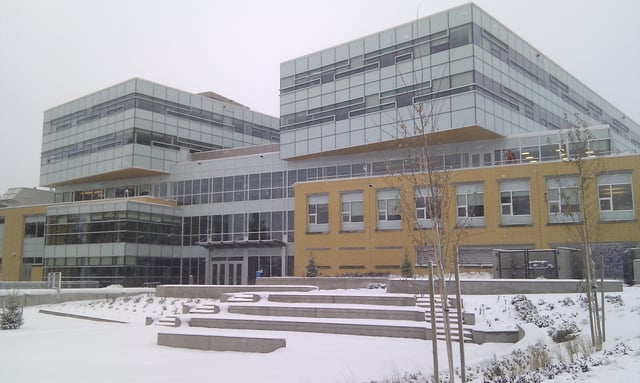
The Engineering (EME) Complex at UBC Okanagan
The Okanagan Campus is a complete transformation of the site of what was once the North Kelowna Campus of Okanagan University College, next to Kelowna International Airport on the north-east side of Kelowna, British Columbia.[31] It is located on unceded land traditionally occupied by the Okanagan Nation.
The campus offers undergraduate and graduate degrees in Arts, Science, Engineering, Nursing, Education, and Management. The Okanagan campus experienced a $450 million CDN expansion with construction of several residential, teaching and research buildings in 2011. The expansion features the Charles Fipke Centre for Innovative Research, the Engineering Management and Education building, the Arts and Science building, and the Health Science Centre. Plans to double the academic and research space are in place for the next two decades.
In 2010, UBC Okanagan campus grew from 105 ha. to 208.6 ha.[32] Like the Point Grey campus, the Okanagan campus attracts Canadian and international students.
Libraries, archives and galleries
The UBC Library, which has 7.8 million volumes, 2.1 million e-books, more than 370,000 e-journals, and more than 700,000 items in locally produced digital collections, is Canada's second largest academic library.[33] From 2014–2015, there were more than 3.8 million on-campus visits and over 9.5 million visits to its website.[34]
The Library has fifteen branches and divisions across the UBC Vancouver and UBC Okanagan campuses.[33]
The former Main Library underwent construction and was renamed the Irving K. Barber Learning Centre. Opened in April 2008, the Learning Centre incorporates the centre heritage block of the old Main Library with two new expansion wings and features an automated storage and retrieval system (ASRS), the first of its kind in Canada.[35]
UBC has a number of different collections that have been donated and acquired. Major General Victor Odlum CB, CMG, DSO, VD donated his library of 10,000 books, which has been housed in "the Rockwoods Centre Library" of the UBC Library since 1963. After Videomatica's 2011 closure, UBC and SFU acquired their $1.7-million collection. UBC received about 28,000 movie DVDs, 4,000 VHS titles and 900 Blu-ray discs which are housed at UBC Library's Koerner branch on the Vancouver campus.[36] In 2014, renowned art collector and antiques specialist, Uno Langmann, donated the Uno Langmann Family Collection of B.C. Photographs,[37] which consists of more than 18,000 rare and unique early photographs from the 1850s to the 1970s. It is considered the premiere private collection of early provincial photos, and an important illustrated history of early photographic methods. In 2016, the Library acquired one of the world's most rare and extraordinary books, the Kelmscott Chaucer from 1896. The book was printed in a limited edition of only 438 copies, but there are only 48 copies in the world with its particular type of binding.[38]
The Morris and Helen Belkin Art Gallery at the UBC houses the University's collection of three archives and fine art; 1,000 works, mainly Canadian contemporary pieces 1960 to the present. The Gallery houses exhibitions, publications, acquisitions, archival projects, lectures and symposia on art history, criticism, and curating.[39]
Governance and academics
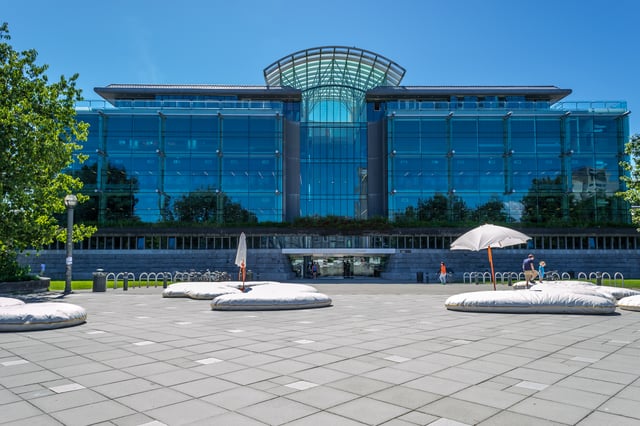
The Walter C. Koerner Library and president's office, designed by UBC alumnus Arthur Erickson
UBC's administration, as mandated by the University Act, is composed of a chancellor, convocation, board, senate, and faculties of the University.[40] The Board of Governors manages property and revenue, while the Senate manages the University's academic operation. Both are composed of faculty and students who are elected to the position. Degrees and diplomas are conferred by the convocation, which is composed of alumni, administrators, and faculty, with a quorum of twenty members. UBC also has a president, who is the university's chief executive officer and a member of the Senate, Board of Governors, Convocation, and also serves as vice chancellor. The president of the University is responsible for managing the academic operation of the University, including recommending appointments, calling meetings of faculties, and establishing committees.
Faculties and schools
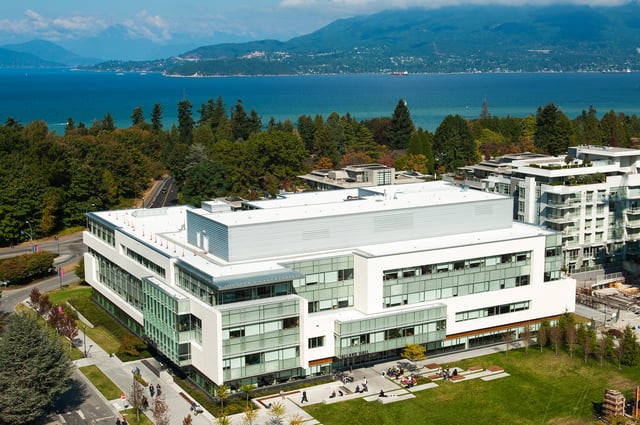
Aerial view of the UBC Faculty of Law building
UBC's academic activity is organized into "faculties" and "schools".[41] UBC has twelve faculties at its Vancouver campus and seven at its Okanagan campus.[11] UBC Vancouver has two academic colleges: Interdisciplinary Studies and Health Disciplines, while UBC Okanagan has a College of Graduate Studies. At the Vancouver campus, the Faculty of Arts, which dates back to the 1915 Fairview Campus, is the largest faculty with twenty departments and schools. With the split of the Faculty of Arts and Science in 1964, the Faculty of Science is the second largest faculty with nine departments. The Sauder School of Business is UBC's Faculty of Commerce and Business Administration. The School of Architecture offers a program accredited by the Canadian Architectural Certification Board at the bachelor level (B.Arch.) and the master's level (M.Arch.).[42] As of December 2012, a new school was created: UBC Vancouver School of Economics in conjunction with the Sauder School of Business.[43][44][45]
In 2014, UBC created a new "International Programs" designation separate from the traditional definition of a Faculty. To accompany this designation, the university created Vantage College to allow international students who do not meet the English language requirements for general admission to enter the university's transition program.[46]
Dual undergraduate degree with Sciences Po
The dual degree program is a highly selective program in which undergraduate students earn two Bachelor of Arts degrees from both Sciences Po in France and UBC in four years. Previously, students could earn one Bachelor of Arts and one Bachelor of Commerce (Sauder School of Business); however, this program was discontinued with the last student intake occurring in September 2017. Currently, students in the dual degree program can only earn a Bachelor of Arts degree from UBC, along with a Bachelor of Arts degree from Sciences Po, which can both be in different majors pertaining to the social sciences. Students spend two years at one of three Sciences Po regional campuses in France (Le Havre, Menton, or Reims), each of which is devoted to a particular region of the world. After two years, students matriculate at UBC. Graduates are guaranteed admission to a Sciences Po graduate program within one-year of graduation.[47]
Enrollment
The mean admission average in 2013 for domestic first-year students was 89.5 percent.[48] The acceptance rate for domestic applications in 2013 was 50.4 percent, of which 57.1 percent enrolled.[49] In 2014/15, UBC employed 3,270 full-time Faculty members, 10,942 non-faculty members, and 8,031 students. It reported 871 unpaid employees.
Reputation
The University of British Columbia has ranked in a number of post-secondary rankings. In the 2019 Academic Ranking of World Universities rankings, the University ranked 35th in the world and second in Canada.[7] The 2020 QS World University Rankings ranked the University 51st in the world, and third in Canada.[8] The 2020 Times Higher Education World University Rankings ranked the University 34th in the world, and second in Canada.[9] In the 2019 U.S. News & World Report Best Global University Ranking, the University ranked 29th in the world and second in Canada.[10] The Canadian-based Maclean's magazine ranked the University of British Columbia third in both their 2019 Canadian Medical Doctoral University category, and their reputation rankings.[52] The University was ranked in spite of having opted out — along with several other Universities in Canada — of participating in Maclean's graduate survey since 2006.[54] In Newsweek's 2011 global university rankings, the University was ranked eighth among institutions outside the United States and second in Canada.[55]
Along with academic and research-based rankings, the University has also been ranked by publications that evaluate the employment prospects of its graduates. In the Times Higher Education's 2018 global employability ranking, the University ranked 56th in the world and fourth in Canada.[51] In QS's 2019 graduate employability ranking, the University ranked 38th in the world and third in Canada.[56]
Research
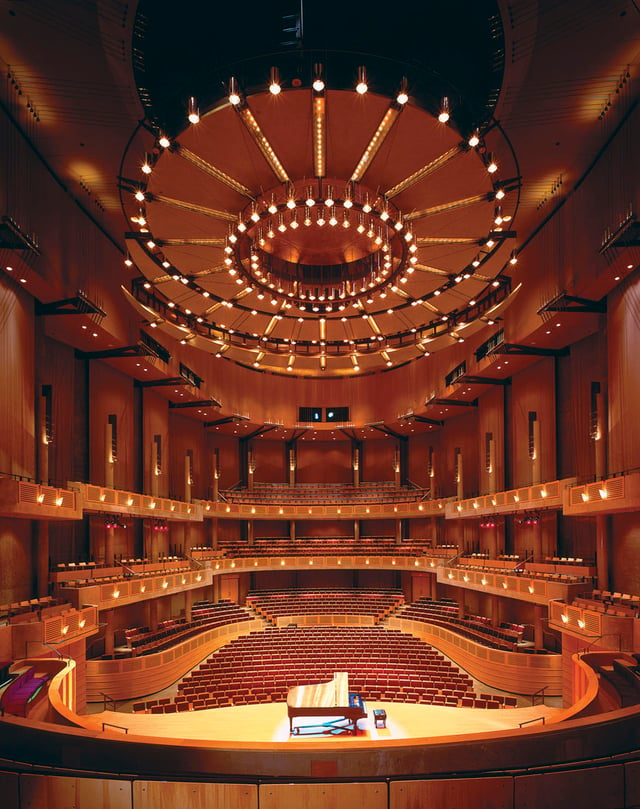
The Chan Centre for the Performing Arts, designed by Bing Thom, B.Arch '66
The University of British Columbia is a member of Universitas 21, an international association of research-led institutions and the only Canadian member of the Association of Pacific Rim Universities, a consortium of 42 leading research universities in the Pacific Rim.[57][58] In 2017, the University of British Columbia had the second-largest sponsored research income (external sources of funding) out of any Canadian university, totalling C$577 million.[59] In the same year, the university's faculty averaged a sponsored research income of $249,900, the eighth highest in the country, while graduate students averaged a sponsored research income of $55,200.[59]
The University has been ranked on several bibliometric University rankings, which uses citation analysis to evaluate the impact a University has on academic publications. In 2019, the Performance Ranking of Scientific Papers for World Universities ranked UBC 27th in the world and second in Canada.[60] The University Ranking by Academic Performance 2018–19 rankings placed the university 27th in the world and second in Canada.[61]
The University operates and manages a number of research centres:
In 1972, a consortium of the University of British Columbia and four other universities from Alberta and British Columbia established the Bamfield Marine Sciences Centre. Located on Vancouver Island, the centre provides year-round research facilities and technical assistance for biologists, ecologists and oceanographers.[62]
The Peter Wall Institute for Advanced Studies is an interdisciplinary research institute for fundamental research in the Sciences, Social Sciences, and Humanities.
The UBC Farm is a 24-hectare (59-acre) learning and research farm in UBC's South Campus area. It features Saturday Farm Markets from early June until early October, selling organic produce and eggs to the community.
TRIUMF, a laboratory specializing in particle and nuclear physics, is also situated at the University. The name was formerly an acronym for Tri-University Meson Facility, but TRIUMF is now owned and operated by a consortium of eleven Canadian universities. The consortium runs TRIUMF through a contribution of funds from the National Research Council of Canada and makes TRIUMF's facilities available to Canadian scientists and to scientists from around the world.[63]
BC Centre on Substance Use (BCCSU) and UBC have established Professorships in Cannabis Science in 2018 following Canada's legalization of cannabis.[64]
Sustainability
UBC has been ranked in the Corporate Knights school rankings, which ranks Universities based on how well they integrate sustainability into the learning experience. The rankings adopt a broad definition of sustainability which encompasses both environmental and social concerns. In the 2011 rankings, UBC was ranked 2nd in the category: top 5 teaching programs.[65] UBC's law school ranked fifth among Canadian law schools.[65] The Sauder School of Business' MBA programs were ranked fourth in Canada. The same rankings placed the business school 11th in Canada for its undergraduate business program.[65]
The University strives to be a world leader in sustainability and sustainable development, aiming to meet the needs of the growing student and faculty population while preserving the environment. The Center for Interactive Research on Sustainability (CIRS) building, a recent addition to the Vancouver campus, exemplifies the University's sustainable practices. Developed to create the most sustainable society at UBC, it has been called North America's most sustainable, innovative, and high performance building.[66]
The CIRS building was first thought of in 2000[67] and was the brainchild of John Robinson, a sustainable development research initiative professor. Robinson worked with faculty members from Emily Carr, Simon Fraser University, and British Columbia Institute of Technology as well as head architect Peter Busby to design the building.[68] It cost 23 million dollars to complete the 65,000 square foot building.[69]
The CIRS building exhibits regenerative sustainability, which means the building improves the surrounding environment.[70] For example, it uses energy it obtains from the neighbouring Earth and Ocean Sciences (EOSC) Building to heat itself. The EOSC building uses roughly 1600 megawatts of heat energy and goes through ten air changes every hour, which wastes around 900 megawatts of energy.[67] The engineers who built the CIRS building saw this as an opportunity; the building takes the heat the EOSC building expels and uses 300 megawatts to heat itself before returning 600 megawatts to the EOSC building. In this way, the CIRS building restores its surrounding environment.
The CIRS building is designed to be net positive in four ways environmentally, meaning the processes or products that leave the building are more environmentally friendly than those that go into it.[66] The best example of the building's net positivity is the building's wood holds nearly 600 tons of carbon – more carbon than the building's construction and maintenance created.[71] Other sustainable features of the CIRS building include:
A water supply obtained entirely from rainwater
An on-site sewage treatment facility that converts all waste created in the building to reusable water and compost
The building's wood comes from trees killed by the pine beetle, thus, little logging was needed for construction
Relies on mainly solar energy for electricity
All areas of the building use natural lighting during the day.[66]
The building integrates 'green' sustainable and humane features, i.e. not only does it have a small ecological footprint, it also serves as an environment for occupants to be happy, healthy, and productive.[68] This is the direction the University of British Columbia is moving towards to continue their ideas of sustainable development.
Following the success of the CIRS, UBC's new Student Union Building, which opened in summer 2015, was also designed to adhere to the most stringent sustainability requirements. It achieves the LEED Platinum standard – with features that include triple glazing, solar-powered cooling, solar water heaters, radiant heating and cooling in floors, green roof technology, water efficient landscaping that uses greywater, natural air ventilation, and a composting facility that processes up to 30 tonnes of organic waste each year.[72]
Canada has the highest water consumption per capita in the world, and Vancouver having the highest population in British Columbia, water consumption is significantly high.[73] The water consumption in the University of British Columbia in Vancouver is significantly high due UBC being the largest University in British Columbia. Due to the high population, the consumption of water sums up to about four billion litres a year, able to fill 1,600 Olympic-sized swimming pools.[74]
Water Action Plan
To implement change in the water consumption, UBC sustainability team created an initiative to conserve called the Water Action Plan in 2011 to reduce and recycle water on campus. Two landmarks for creating water sustainability are the CIRS and the C. K. Choi Building. The Centre for Interactive Sustainability (CIRS) building features a closed loop water system where water is recycled and reused. On the other hand, the C. K. Choi Building for the Institute of Asian Research, consists of composting toilets, which reduce domestic water consumption. These toilets use an alternative other than using water for flushing and produce fertilizer that can be used for growing plants. Conclusively, these toilets allow for conservation of water, landfill space, energy, and also production of quality fertilizer.
Water conservation initiatives
For over 20 years, UBC has been implementing change and water consumption policies through two initiatives, ECOTrek and UBC Renew:
ECOTrek ECOTrek is Canada's largest sustainability project which undertook an enormous water and energy saving initiative. This project included rebuilding almost 300 academic buildings in UBC. This project achieved a World Clean Energy nomination, which are honorable awards for successful projects in energy efficiency and renewable energy realm.[75] The water management involved conducting changes to toilets, urinals, basins and water-cooled equipment to reduce the amount of water on campus. In addition, steam and water meters were installed on campus to quantify the water consumption to provide a clear depiction of the water use in each building.
UBC Renew UBC Renew project involves renovating aging institutional buildings, instead of demolishing and building new buildings which can have negative impacts on the environment. Demolition can have major environmental impacts as it can pollute the soil, increase air pollutants, and increase water consumption. Renovating old buildings can save large volumes of water and save energy costs.
Community efforts
Beyond the UBC sustainability team, a student-driven initiative is taking place in making a bottled-water free campus in hopes of reducing bottled water on campus and to encourage students to engage in environmentally friendly behaviours. Production of bottled water puts strain on the environment and increases landfill space. According to the World Wide Fund for Nature 2001 report, about 1.5 million tons of plastic is used for bottling 89 billion litres of water each year.[76]
Indigenous
UBC's Longhouse is the University's centre for Indigenous activities. The University has an associate dean of Indigenous Education, and has developed governing board and senate policies as well as Aboriginal governed councils within the University structure.[77] UBC offers degrees in First Nations and Indigenous Studies[78] through a program in the Arts Faculty, and a Chinook Diploma Program in the Sauder School of Business; it also runs the Chinook Summer Biz Camp, to foster entrepreneurship among First Nations and Métis high school students. It hosts a Bridge Through Sport Program, Summer Science Program, Native Youth Program, and Cedar Day Camp and Afterschool Program. Its First Nations Forestry Initiatives were developed in partnership with specific Aboriginal communities to meet needs in their more remote areas.
Finances
In 2012–13, UBC's budget exceeded $2 billion, and the University posted balanced financial results for the fourth consecutive year through strategic revenue diversification, careful management of assets, and a continued focus on fundraising for projects across the university. The share of the University budget coming from the government grant has been reduced to 45% of total revenues. On the other hand, annual fundraising has nearly doubled in 5 years to reach $213 million.
Tuition
Tuition fees vary significantly between Canadian citizens (and permanent residents) and international students. In addition, for both undergraduate and graduate programs, tuition rates vary among the University's faculties. Students must also pay for various living expenses such as housing, food and health care. As of the 2012–2013 school year, these expenses were estimated at around $13,000 CAD per academic year.[79][80][81]
Undergraduate tuition
UBC tuition for 2012 was $4,700 before adding other mandatory administrative fees for a Canadian student in a basic 30-unit program, though various programs cost from $3,406 to $9,640. Tuition for international students is significantly higher (2.3–4.6 times higher than domestic students). In 2012, tuition for international students ranged from $16,245 CAD to $25,721 CAD.[82]
In 2001–02, UBC had one of the lowest undergraduate tuition rates in Canada, at an average of $2,181 CAD per year for a full-time programme due to a government-instituted tuition freeze.
In 2001, the BC Liberal party defeated the NDP in British Columbia and lifted the tuition freeze. In 2002–03 undergraduate and graduate tuition rose by an average of 30%, and up to 40% in some faculties. This has led to better facilities, but also to student unrest and contributed to a teaching assistant union strike.
UBC again increased tuition by 30% in the 2003–04 year, again by approximately 15% in the 2004–05 season, and 2% in the 2005–06 and 2006–07 years. Increases were lower than expected because, in the 2005 Speech from the Throne, the government announced tuition increases would be capped to inflation.[83] In 2006–07, the Canadian average undergraduate tuition fee was $4,347 and the BC average was $4,960.[84] In 2014, the Board of Governor passed a one-time 10% tuition increase for all new incoming International students.[85] In December 2015, UBC's Board of Governors passed a motion increasing international tuition by more than 46.8% for the academic years 2016–17, 2017–18, 2018–2019. This announcement was met with indignation by many of the University's students as this was the second major increase in international tuition in less than a year, taking total international student tuition fee increases to above 60% within 4 years (minimum international tuition will be benchmarked at $35,071 CAD in the year 2018–19).[86]
Graduate tuition
In the academic year 2019/2020, graduate programs assess tuition fees that vary significantly, depending on the program and the student's citizenship.[87][88] International students without external funding that meet the general eligibility criteria will be supported with guaranteed funding of up to $3,200 per year.[89] Tuition for professional Master's programs varies.
Student life
Student representation
The Alma Mater Society of the University of British Columbia, or AMS, represents UBC undergraduate students within the Vancouver campus. The society's mandate is to improve the quality of educational, social, and personal lives of UBC students. The AMS lobbies the UBC administration on behalf of the student body, provides services such as the AMS/GSS Health and Dental Plan, supports and administers student clubs, and maintains the Student Union Building (aka SUB) and the services it houses. A Constituency (undergraduate society) exists within each schools and faculties of the University and act as the subsidiary of the AMS within those schools and faculties.
The Graduate Student Society (GSS), which operates as an independent entity, represents graduate students. A council representing each graduate program and an executive elected by graduate students as a whole governs the GSS.[90]
The university also allows elected student representatives to sit as voting members in the Board of Governors (3 student representatives) and the Academic Senate. Although the university is the official body that elects the students, the university delegates these representative elections to the AMS.
Student facilities

The new Student Union Building, which opened in 2015
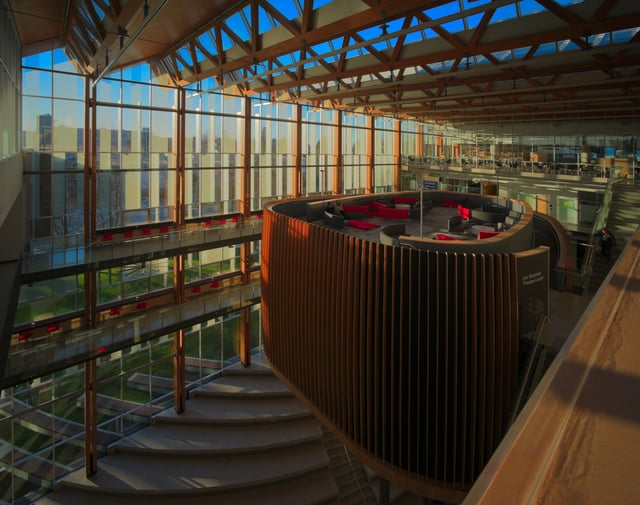
The interior of the new Student Union Building contains a "bird's nest" where students may relax and study.
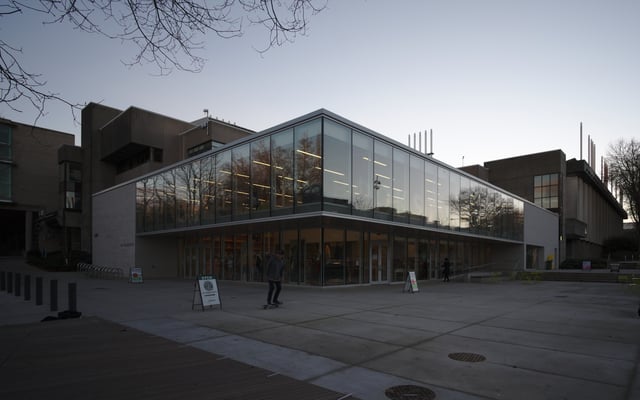
Exterior of the main UBC Bookstore.
The heart of student activity at UBC Vancouver is the centrally located Student Union Building (SUB), which houses offices of many AMS student clubs, over a dozen restaurants and cafés, a pub ("The Gallery"), a nightclub ("The Pit"), the 425-seat Norman Bouchard Memorial Theatre ("The Norm Theatre"), several shops, and a post office. The AMS runs the majority of the SUB's outlets and shops; however, UBC Food Services' recent addition of major corporate outlets has generated controversy. The SUB Art Gallery contains mostly students' works. An underground bus loop to replace the "Grassy Knoll" beside the SUB did not receive funding by Translink.[91] As a result, the administration has cancelled the bus loop project, although the rest of the renovations of the University Boulevard Neighbourhood are still under consideration.
In June 2015, the new Student Union Building—called the AMS Student Nest or simply the "Nest"[92]—opened to students, largely replacing and extending the old SUB in functionality.[72] The Nest, built for $107 million, is much larger than its predecessor, and has numerous amenities including a performance centre, an art exhibition space, a large ballroom, a three-storey climbing wall, radio broadcast facilities, a daycare, and a 10,740 square foot rooftop garden and public space with a water feature and outdoor seating. Many of the restaurants as well as the Pit Pub have moved to the Nest under their original name or with new names.[72]
Other student facilities on campus include the Ladha Science Student Centre (funded through a donation from Abdul Ladha, a levy on Science undergraduate students, the VP Students, and the dean of Science) and the Meekison Arts Student Space in the Faculty of Art's Buchanan D building. The UBC Bookstore's locations on the Vancouver campus: the main store at 6200 University Boulevard and a store at Sauder School of Business join the stores at the Okanagan and Robson Square Campuses in offering a variety of products and services. The bookstores return a dividend to UBC each year, which is re-invested in the campus or in student and community organizations.[93]
Greek organizations
While UBC's Greek system is somewhat smaller than its counterparts in the United States, UBC's 18 Greek organizations make up Canada's largest and most active Greek system. The Alma Mater Society recognizes an InterFraternal Council (IFC) as a club, and weekly meetings of the fraternities under IFC take place at their respective fraternity houses. Greek life has its own division within UBC REC[94] and intense competition between the nine Fraternities for the title of top Athletic Fraternity occur.
There are ten international fraternities on campus, the first of which was Zeta Psi, in January 1926. Although its disputed, Alpha Delta Phi soon came to campus and chartered 3 months later. However, Zeta Psi and Alpha Delta Phi were preceded by several local fraternities on campus. Other fraternities include Alpha Epsilon Pi, Delta Kappa Epsilon, Psi Upsilon, Sigma Chi,[95] Beta Theta Pi,[96] Phi Delta Theta, Phi Gamma Delta, Kappa Sigma, and Zeta Psi, which re-chartered at UBC in 2013.
The National Panhellenic Conference (NPC) member organizations (sororities) on campus are overseen by the Panhellenic Council.[97] All sororities have a chapter room in the Panhellenic House on Wesbrook Mall; the building also offers housing for 72 college women, with preference given to sorority members.
The eight sororities on the Vancouver campus include Alpha Delta Pi, Alpha Gamma Delta, Alpha Omicron Pi, Alpha Phi, Delta Gamma, Gamma Phi Beta, Kappa Alpha Theta, and Kappa Kappa Gamma. The current Panhellenic total is 104. Chapter meetings are held in the chapter's respective rooms each week or in classrooms and Greek-wide or campus-wide events are attended by members of all the sororities and fraternities. Formal recruitment for the sororities begins during the third week of September and is a 4-day process consisting of: tours (first 2 days), invitationals and preference. The formal recruitment process ends with Bid Day, where membership bids from each sorority are distributed to prospective members.
Phrateres has traditionally been affiliated with the Greek system since its installation at UBC in 1935. Historical records indicate that for many years, members identified themselves, and were recognized as Greek. Members interacted with fraternities on a similar basis as the sororities, and participated in many Greek events, such as Songfest and exchanges. However, they presently operate as a self-governing organization under the Alma Mater Society with the closure of their international headquarters in 2001.
Alpha Phi Omega (Community service fraternity) founded its first chapter in Canada at UBC in 2015.
Moreover, UBC was ranked among Canada's top party schools by the website Ask Men. UBC was ranked 8th.[102]
Residences
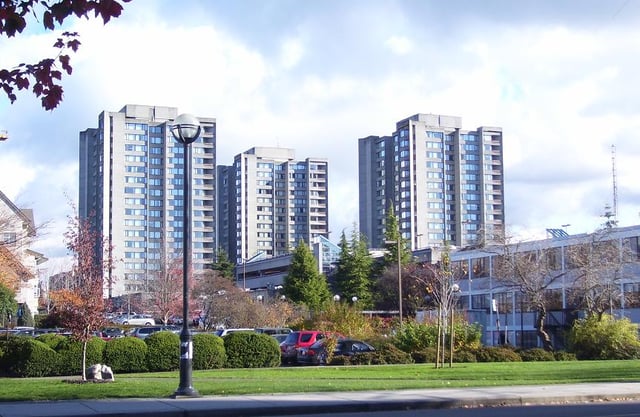
Gage Towers
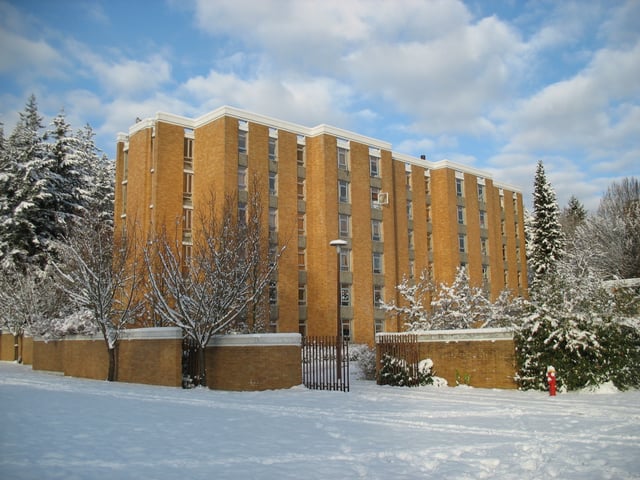
Totem Park, Dene House

Marine Drive
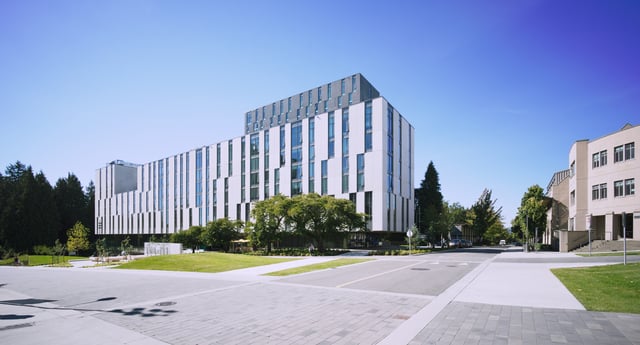
Ponderosa Commons, Oak House
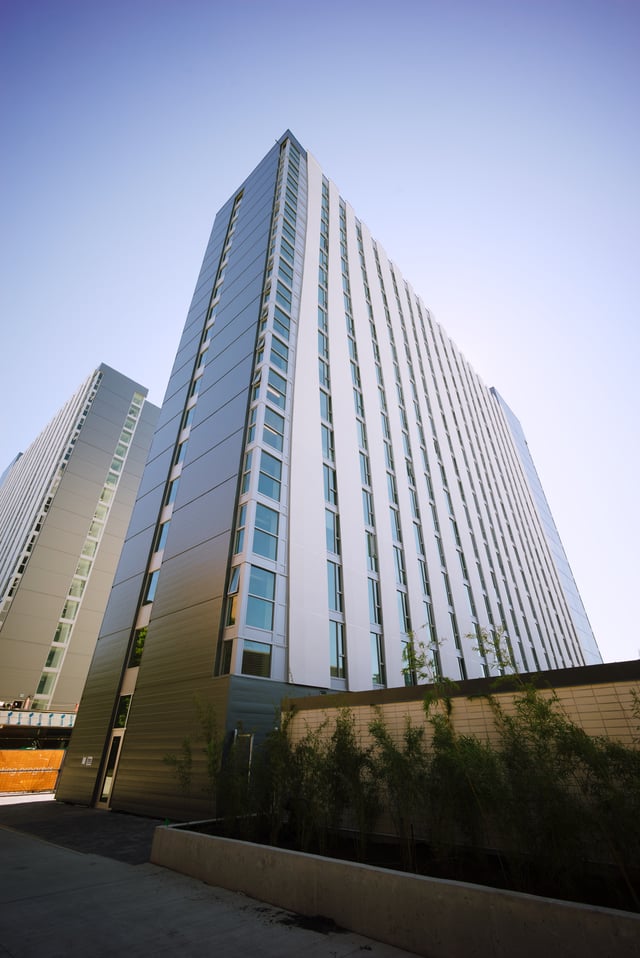
Orchard Commons, Braeburn House
The UBC Point Grey campus has a resident population of about 10,041 students [103] who live in an unincorporated area, outside the City of Vancouver known as Electoral Area A within and partly administered by Metro Vancouver.[104] Neighbouring the University Endowment Lands, on-campus residential services are provided by the Province of BC and by UBC. Emergency Planning is administered by Metro Vancouver. Because UBC is not in a municipality, there is no mayor, council, or other democratic municipal representation for on-campus residents, although residents can vote for the Director of Electoral Area A.[105] British Columbia's Residential Tenancy Act does not protect UBC residents because university accommodations for students and employees are exempt.[106]
UBC has forecast the need for 6,400 new on-campus beds between 2008 and 2028 "to maintain the current availability of student housing choices in the face of on-going pressures in the Vancouver rental market".[107] From 2009 to 2014, UBC added 1,471 beds for student residents.[108][109] In 2015, UBC plans to increase the cost of on-campus student housing by 20%, with the exception of year-round residences.[110]
Totem Park, housing about 2,129 students, consists of nine dormitory buildings (Nootka, Dene, Haida, Salish, Kwakiutl, Shuswap, Həm'ləsəm', Q'ələχən, Building 7), and a Commons Block (Coquihalla). All houses, except Shuswap and Building 7, are co-ed, with alternating men's and women's floors; Shuswap house and Building 7 has co-ed floors. Həm'ləsəm' and Q'ələχən houses were opened to Totem Park residents in September 2011 and have single rooms with semi-private or private washrooms in contrast to the other houses' communal floor washrooms.[112] Building 7 was opened to Totem Park residents in September 2017 and has single rooms with communal bathrooms.
Place Vanier, housing 1,370 people, consists of 12 blocks constructed in 1959 (Robson House), 1960 (Okanagan, Sherwood Lett, Mackenzie, Ross, Hamber, and Mawdsley Houses), 1961 (Kootenay House), 1968 (Cariboo and Tweedsmuir Houses), 2002 (Korea-UBC House) and 2003 (Tec de Monterrey-UBC House). The buildings vary from male and female only, to alternating gender floors, as well as fully mixed floors. The residences have single and double rooms, and each floor has a lounge and communal bathrooms.
Orchard Commons consists of two apartment style buildings, Braeburn house and Bartlett house, with the latter containing a common dining hall and reception area. Orchard Commons houses 1,047 students, with the majority staying in connected single rooms on mixed gender floors, where two same-gender residents share a washroom connecting their adjacent rooms.[113]
Students nineteen and older have suite-style residence options on the Point Grey campus. The Gage Towers consist of three 17-floor towers (North, South and East) primarily for second, third, and fourth-year undergraduate students. It consists of three interconnected towers (North, South, and East) as well as single student housing (both studio, and apartment) in a building. The towers are composed of "quads": four separate pods, each consisting of six individual bedrooms, a bathroom and a kitchen-dining area.[114]
Acadia Park and University Apartments are for student families and couples (where one is a UBC student) and are administered on a year-round basis.[115]
Next to the Acadia Park residence area on the east part of campus is Fairview Crescent, a residence primarily for second- and third-year undergraduate students and many graduate students. The residence consists of an L-shaped pedestrian-only street lined with 4, 5 and six-student (a mix of single-sex and co-ed) townhouses. The Beanery coffee shop is in the middle of the residence. Within a 5-minute walk from Fairview Crescent is the Fraser Hall residence which houses approximately 200 students. Fairview Crescent and Fraser Hall are both governed by the Fairview and Fraser Residence Association.
The Thunderbird residences are primarily for graduate students and fourth-year undergraduate students; they are at the academic core campus' southern edge. The Ritsumeikan-UBC House is a residence with a Japanese cultural setting, named for Ritsumeikan University. It houses Japanese exchange students and Canadian students, who participate in unique inter-cultural programmes. UBC's Urasenke Japanese tea ceremony club uses the residence's tatami room for practice sessions. Two Canadian students are typically paired with two Japanese exchange students.
Marine Drive Residence is on the west side of campus, slightly south of Place Vanier. The first phase, consisting of Building 1 (an 18-floor tower) and Building 2 (a five-floor building commonly called the "Podium") opened in fall 2005. In February 2006, the Board of Governors approved plans for Marine Drive's second phase, putting an end to the debacle caused by concerns over the view of Wreck beach (Phase I's Building 1 was reduced from 20 floors to 18). Additionally, building 1 contains the Simon K.Y. Lee Global Lounge and Resource Centre. Phase II consists of Buildings 4 through 6 (two towers and another "Podium", respectively), and also the Commonsblock. Buildings 4 through 6 were all open to students as of September 2008. A separate Commonsblock was completed in summer 2009, and has similar services to the Commonsblock of other residences, such as exercise, game, and study rooms. Construction at Marine Drive was completed in February 2010, with the opening of The Point Grill restaurant in Building 4.
The newest additions to UBC Vancouver's student housing are the Ponderosa Commons and Orchard Commons residences, completed in 2016, and Brock Commons, opened in the Summer of 2017.
Athletics
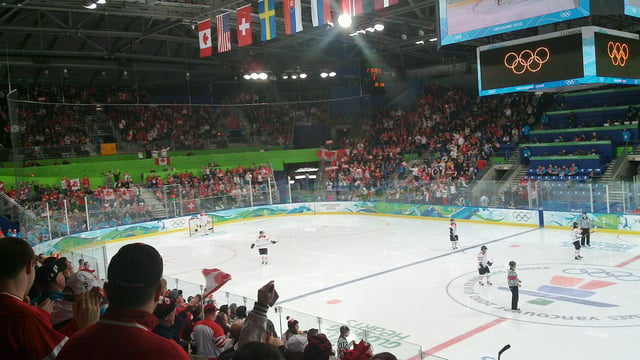
UBC's Doug Mitchell Thunderbird Sports Centre during the 2010 Winter Olympics
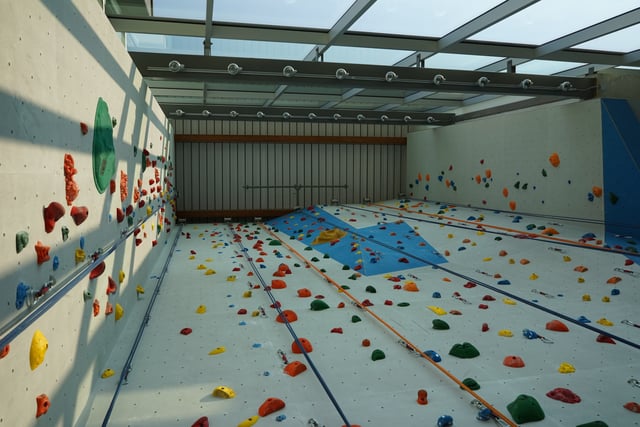
Indoor climbing at the Student Union Building.
The University of British Columbia's sports teams are called the Thunderbirds. The Thunderbirds participate in the U Sports Canada West Universities Athletic Association for most varsity sports. However, several varsity teams at UBC compete in the National Association of Intercollegiate Athletics. Circa 2007–2008, UBC was considering joining the NCAA Division II.[120][121] With a long history of competing in sports, the Thunderbirds have garnered a number of championships. In particular, the women swimmers who had represented UBC had brought back 22 conference championships and 16 national championships.[122]
The University of British Columbia has a number of athletic facilities open to both their varsity teams as well as to their students. The stadium with the largest seating capacity at UBC is the Doug Mitchell Thunderbird Sports Centre. The Doug Mitchell Thunderbird Sports Centre is home to the varsity ice hockey teams and was also used as a venue for the 2010 Winter Olympics.[123] Other facilities at UBC includes Thunderbird Stadium, home to the university's football and soccer varsity teams, UBC Aquatic Centre, home to the university's swimming teams, the War Memorial Gymnasium, home to the university's basketball and volleyball varsity teams and Thunderbird Park, home to the university's many other outdoor varsity teams.[124]
The university has also had a long history of sending a number of students to represent their countries at the Olympics. Since having its first athlete sent to the Olympics in 1928, a total of 231 individuals from UBC have represented their respective countries at the Olympics. The total number of individual medals athletes from UBC had won was 61, with 19 gold, 21 silver and 24 bronze. The majority of these medals won had come from the sport of rowing.[125]
Marching band
UBC's marching band, the Thunderbird Marching Band, was founded in September 2012 and is entirely student-run. The band performs at various Thunderbirds football, basketball, rugby, and hockey games, as well as other campus events. It is the only university-level marching band in Western Canada.[126]
Fight song
Notable among a number of songs commonly played and sung at various events such as commencement and convocation, and athletic games are: "Hail, U.B.C" with words and music by Harold King and "High on Olympus" with words by D. C. Morton and music by J. C. F. Haeffner.[127]
Campus events
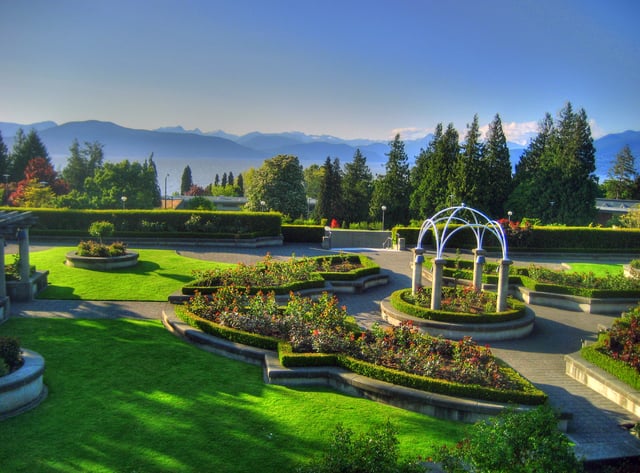
UBC Rose Garden
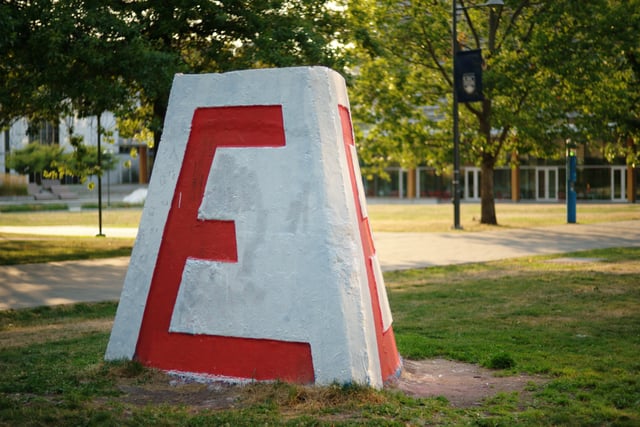
The UBC Engineering Cairn, a chamfered tetrahedral concrete block with a large red "E" on each of its three sides, shown here in its unvandalized state. Painting the cairn is a favourite hobby of student clubs and rival faculties.
A small number of large-scale, campus-wide events occur annually at UBC which are organized by university institutions, the AMS, and student constituencies of various faculties and departments. Additionally, a number of unofficial traditions exist at UBC: jumping from the Aquatic Centre's 10-metre diving board late at night and repainting the Engineering cairn so as to advertise other clubs.
Several group athletic events take place at UBC every year. Storm the Wall is an intramural relay race put on by UBC Recreation in April, culminating in the climbing of a 12-foot (3.7 m) wall. Day of the Longboat is an intramural event put on at the end of September/early October by UBC Recreation. It is a major voyageur canoe race with teams competing in a 2 km paddle around the waters of Jericho Sailing Centre. The program is operated by over 120 volunteer students and staff who are responsible for operating every aspect of this program. UBC Recreation's student administrators fill various roles including event planning, sport officiating, public relations and building supervision.
Faculty constituencies, such as the Arts Undergraduate Society (AUS) and Science Undergraduate Society (SUS), hold events annually. Many of the major constituencies, such as for Arts, Science, and Engineering, hold their own faculty weeks to celebrate their faculties. The events may include keynote speeches, merchandise sales, and dances. Arts County Fair was an annual concert and party on the last day of classes in April, put on by the AUS and occurring at Thunderbird Stadium. Past headliners have included Sam Roberts, The New Pornographers, and Metric. Due to increasing financial difficulties (mostly resulting from mounting security and related costs) the AUS announced they would not continue the event in 2008. In its place, the Alma Mater Society of UBC hosted the AMS Block Party to celebrate the end of classes.
During the Spring exam season, the Ski & Board Club organizes the Undie Run, a charity event that encourages people to donate their clothes to the Big Brothers & Sisters organization in Vancouver. Students meet at the Student Union Building, remove the clothes they are going to donate, and then run around campus in their underwear. Students run through places like the Irvin K. Barber Centre and Place Vanier Residence before ending at the Martha Piper Plaza fountain.
To celebrate the beginning of classes, UBC Orientations organizes several events for first-year students, such as Imagine UBC, GALA, and UBC Jump Start. Imagine UBC is an orientation day and pep rally for first-year undergraduate students that replaces the first day of class after Labour Day at UBC Vancouver.[128]
Rape chant controversy
During the 2013 Imagine day, a post on Twitter showed first year students in the Sauder School of Business singing a chant that bragged about rape. The chant, dating back to at least 1993, had already created controversy at Saint Mary's University days earlier.[129] The Commerce Undergraduate Society stated that it had been trying to scale back the cheer by using it in buses but not outside. Four CUS leaders resigned over the incident and 81 others were required to perform an unspecified amount of community service by the UBC president, Stephen Toope.[130]
Model United Nations
In March 2012, UBC was the partner Host University of the Harvard World Model United Nations Conference (WorldMUN 2012 Vancouver). As the world's largest student-organized Model UN conference, this was also the largest student conference to have ever been organized by UBC and the largest student conference on Canadian soil.[131][132] There were 2,200 student delegates and nearly 200 faculty advisors from 270 universities from over 60 countries. The organizing committee amassed over 500 student volunteers from across the UBC campus and the local student community to execute the week-long event.
Notable people
Former alumni have won Nobel Prizes: Robert Mundell (Economic Sciences) who graduated from the UBC Department of Economics and Bertram Brockhouse (Physics).[134][135] Five former faculty members of the UBC have also received a Nobel Prize: Michael Smith (Chemistry), Har Gobind Khorana (Physiology or Medicine), Daniel Kahneman (Economics), Hans G. Dehmelt (Physics), and Carl Wieman (Physics).[136][137][138][139]
Many former students have gained local and national prominence in government. The university has produced three Canadian Prime Ministers: John Turner, Kim Campbell, and Justin Trudeau.[140][141] The leader of the Liberal Party of Canada, Member of Parliament and the 23rd Prime Minister of Canada Justin Trudeau completed his BEd. at UBC in 1998.[142] Canadian Prime Minister Joe Clark briefly attended UBC law.[143] George Stanley, the Lieutenant Governor of New Brunswick and creator of the Canadian flag had also served as faculty.[144] Alumni Mike Harcourt, Glen Clark and Ujjal Dosanjh have been Premiers of British Columbia:,[145][146][147] People of UBC Law have also served on the Supreme Court of Canada: former faculty member Beverley McLachlin and alumnus Frank Iacobucci.[148][149] Other examples are
Canadian academic, science broadcaster and environmental activist David Suzuki was a professor in UBC's genetics department from 1963 until his retirement in 2001.
Joel Bakan, author of The Corporation: The Pathological Pursuit of Profit and Power, is a professor at the Faculty of Law.
Psychologist Albert Bandura is an alumnus of UBC.
Actress Evangeline Lilly attended UBC and earned her degree in International Relations.
Singer/songwriter Dan Mangan attended UBC, earning a BA in English Literature.[150]
Author and historian Pierre Berton majored in history at UBC.
Man-in-Motion Rick Hansen was the first student with a physical disability to graduate in physical education from UBC.
Opera singers Judith Forst, Ben Heppner and Lance Ryan studied music at UBC.
David Cheriton, who graduated from UBC in 1973, is a Google founding investor and computer science professor at Stanford University.[151]
Science fiction writer William Gibson, who coined the term "cyberspace", earned his bachelor's degree in English at UBC.[152]
Actor Manny Jacinto graduated with a degree in Civil Engineering.[153]
UBC alumni have also held important positions in the academia. Notable examples are:
Indira Samarasekera, twelfth president of the University of Alberta;[154]
Amit Chakma, president of the University of Western Ontario;[155]
Muriel Kennett Wales, believed to have been the first Irish-born woman to earn a PhD in pure mathematics.
John H. McArthur, dean emeritus of the Harvard Business School;[156]
Thomas Franck (lawyer), who was the Murry and Ida Becker Professor of Law at New York University and former Editor-in-Chief of the American Journal of International Law;[157]
David H. Turpin, sixth president of the University of Victoria and thirteenth president of the University of Alberta;[158]
Nemkumar Banthia, a fellow of the Royal Society of Canada and CEO of IC-IMPACTS.[159]
Michiel Horn, member of the Royal Society of Canada and professor emeritus of history at York University;[160]
Monica Lam, a computer science professor at Stanford University and founder of Moka5;[161]
Frank Iacobucci, a Puisne Justice on the Supreme Court of Canada.
See also
CITR-FM
UBC Botanical Garden and Centre for Plant Research
UBC Library
UBC Okanagan
List of Canadian universities by endowment


